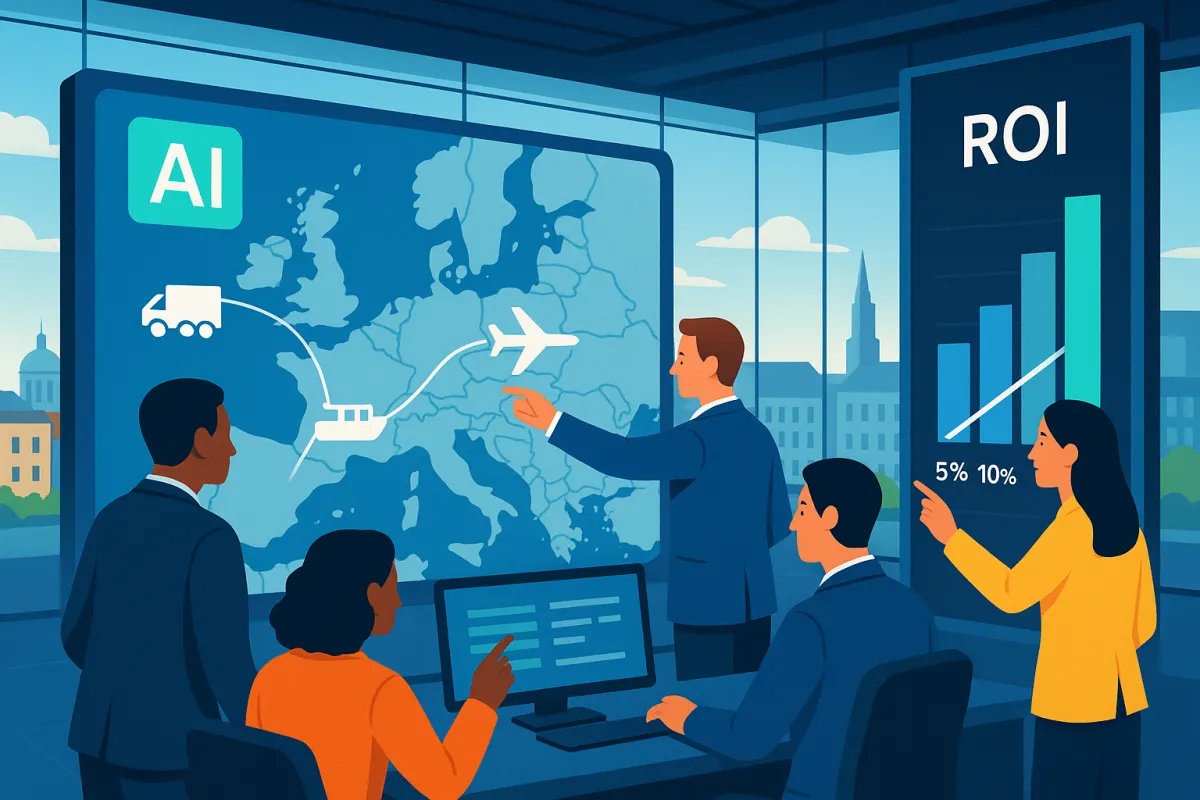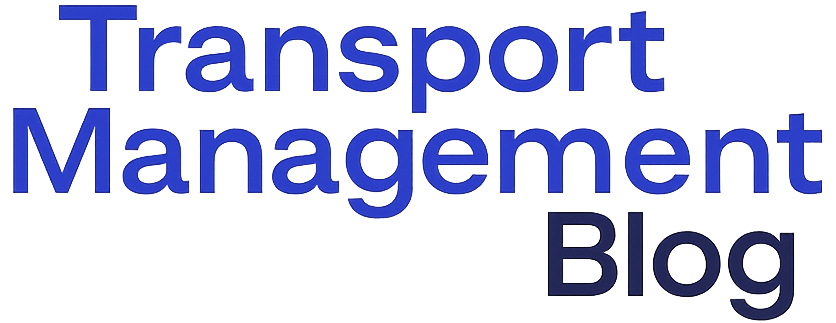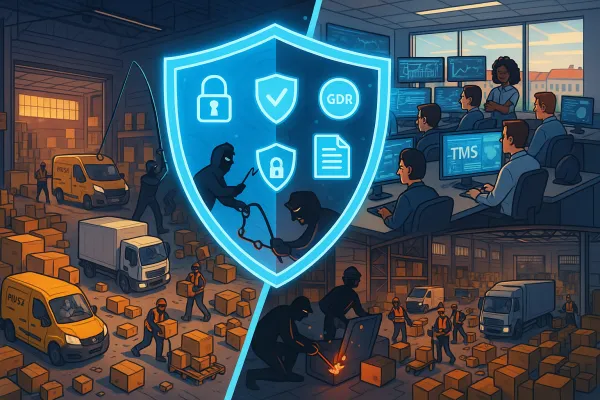The European Shipper's Guide to Measuring AI-Powered TMS ROI: How to Calculate, Track, and Maximize Returns from Predictive Analytics in 2025

European manufacturers facing €20M+ annual transport budgets know the drill: every board meeting brings the same question about AI-powered TMS investments. You've heard the promises. AI systems now achieve 98% forecasting accuracy and reduce supply chain errors by 20-50%. The European artificial intelligence market alone reached €53.03 billion in 2024, with logistics leading the charge.
But here's what the marketing brochures won't tell you: many still struggle when it comes to locking down exactly how to explain their value — and more importantly, how much it will save them. Most European shippers operate without clear frameworks for measuring AI-powered TMS ROI. You need concrete numbers for your next budget meeting.
The €2M Question: Why European Shippers Need Better AI ROI Frameworks
Walk into any European logistics conference and you'll hear the same frustration. Supply chain directors at €100M+ revenue companies admit they can't demonstrate clear financial impact from their TMS investments. Based on freight spend, the following rates of TMS adoption apply, yet ROI measurement remains elusive.
The numbers paint a stark picture. The Europe Terminal Management System (TMS) size was valued at USD 158.37 Million in 2024 and is projected to reach USD 378.33 Million by 2032 at CAGR of 11.5%. Meanwhile, Germany dominated the terminal management system (TMS) market with the largest revenue share of 32.14% in 2024. Yet companies struggle to connect these investments to bottom-line results.
Here's the gap: AI promises versus measurable business value. European manufacturers report spending €200K-€500K on TMS implementations, often without establishing baseline metrics or clear success criteria. You're not alone if your finance team questions every AI initiative.
The Real Cost of Manual Processes (Baseline Measurement)
Before measuring AI gains, calculate what manual processes actually cost. A transport manager earning €60K annually spends roughly 15 hours weekly on manual routing, carrier communication, and invoice reconciliation. That's €22K annually in opportunity cost for a single person.
Hidden costs multiply quickly. Suboptimal routing adds 8-12% to fuel expenses. Manual dispatch errors trigger customer complaints and relationship damage. Carrier performance tracking through spreadsheets misses optimization opportunities worth 5-15% of transport spend.
Start your baseline measurement by documenting current time spent on repetitive tasks, error rates in manual processes, and missed optimization opportunities. The tool makes some assumptions based on your business' revenue, cost assumptions, and industry benchmarks to simplify and speed up data entry.
The Four Pillars of AI-Powered TMS ROI Measurement
Pillar 1: Demand Forecasting Accuracy Gains
AI-based forecasting transforms supply chain management by reducing errors by 20-50%. For a European manufacturer with €50M transport spend, even 15% improvement in forecast accuracy translates to €750K annual savings through better capacity planning and reduced emergency shipments.
Calculate ROI using this framework: (Forecast error reduction %) × (Emergency freight premium %) × (Annual transport volume). A consumer goods company reduced wrong forecasts by 30%, eliminating €2M in expedited shipping costs. The AI system paid for itself in eight months.
TMS solutions consider historical and current reports on demand trends, consumer behavior patterns, seasonal fluctuations, etc to build algorithms to predict the demand scenario. Track weekly forecast accuracy improvements. Document reduced stockout incidents and their cost impact. Measure eliminated rush orders and premium freight charges.
Implementation timeline typically shows results within 60-90 days. European automotive suppliers report 25-40% improvement in demand forecast accuracy within the first quarter of AI deployment.
Pillar 2: Route Optimization and Fuel Savings
Route optimization delivers immediate, measurable returns. A TMS that is capable of consolidating your orders to optimize loads, routing, and scheduling can deliver significant and rapid savings to your operations. Optimization capabilities could include those that allow for the usage of preferred carriers, a range of modes from which to select the lowest cost, load optimization, and more.
With European diesel averaging €1.57/L in Q4 2024, even modest route improvements generate substantial savings. The platform uses real-time data and analytics to improve operational efficiency and saves the company $100-200 million in costs, as demonstrated by UPS's ORION system.
Calculate savings using: (Kilometers saved per route) × (Average cost per km) × (Number of routes annually). European trucking typically costs €0.45-€0.65 per kilometer. A 15% route optimization on 10,000 annual routes averaging 200km each saves €135,000-€195,000 annually.
AI-powered systems integrate real-time traffic data, weather conditions, and driver availability. They automatically adjust routes for maximum efficiency while ensuring compliance with European regulations including Smart Tachograph and upcoming eFTI requirements.
Pillar 3: Carrier Performance and Procurement Optimization
Gartner® calculates the ROI of analytics capabilities at "between 1% to 3%." automation capabilities could generate an ROI of between 1% and 3% on freight cost savings alone for your organization. Gartner® calculates the ROI of analytics capabilities at "between 1% to 3%."
AI-driven procurement extends these savings further. Predictive analytics identify which carriers perform best under specific conditions, seasonal patterns, and route types. European companies report 10-15% additional savings beyond basic automation through intelligent carrier selection.
Automated tender management eliminates manual bid processes. A €30M annual transport spend company reduced procurement cycle time from 6 weeks to 3 days using AI-powered platforms like Cargoson, alongside solutions from Transporeon, nShift, and Descartes.
Measure procurement ROI through: reduced bid cycle time, improved carrier performance scores, penalty reduction, and contract compliance improvements. Track average cost per shipment before and after AI implementation across different lanes and seasons.
Pillar 4: Operational Efficiency and Automation
Automation is another area where a TMS can provide significant savings, not just on cost but on the time spent performing daily tasks. From payments and contract creation to tracking alerts and exception management, the ability to automate time-consuming manual processes helps to eliminate the risk of human error while allowing for decisions to be guided by accurate real-time data.
It optimizes warehousing costs (5-10% reduction) and slashes administration expenses (25-40% savings). For European operations, this translates to significant FTE savings and error reduction.
Calculate automation ROI by documenting hours saved per process multiplied by loaded labor costs. A logistics coordinator spending 20 hours weekly on manual tasks (€50K salary) represents €25K annual opportunity cost. AI automation typically eliminates 60-80% of these manual tasks.
Track metrics including: invoice processing time, exception handling response time, document preparation accuracy, and customer query resolution speed. European companies report 40-70% reduction in administrative overhead within six months.
60-Day ROI Measurement Framework
Most European TMS deployments show measurable ROI within the first quarter, but you need weekly tracking to ensure success. Start by building your business case with a discovery workshop and detailed ROI calculation report.
Week 1-2: Establish baseline metrics. Document current manual process times, error rates, and cost per shipment across different routes and carriers. Capture data on forecasting accuracy and emergency shipment frequency.
Week 3-8: Implement AI features incrementally. Start with route optimization for immediate wins, then add demand forecasting and carrier performance analytics. Track improvements weekly against baseline metrics.
Week 9-12: Measure full system impact. Calculate cumulative savings across all four pillars. European consumer goods manufacturers typically see 12-18% improvement in transport efficiency by month three.
Weekly KPIs include: cost per kilometer, forecast accuracy percentage, on-time delivery rate, and manual task hours. Create executive dashboards showing weekly savings and cumulative ROI progression.
Real-World ROI Examples from European Implementations
A German automotive supplier with €25M annual transport spend implemented AI-powered TMS at €300K total cost. Results after 12 months: €450K savings through 18% route optimization, 25% improvement in demand forecasting accuracy, and 35% reduction in administrative overhead. Net ROI: 50%.
In June 2025, Modern Transportation achieved annual savings of USD 5 million after implementing BeyondTrucks' multi-tenant TMS. European implementations show similar patterns: initial investment of €200K-€500K generating €400K-€800K annual benefits.
Industry benchmarks from successful implementations across Europe show: 15-25% reduction in transport costs, 30-50% improvement in forecast accuracy, and 40-60% reduction in manual processing time. ROI typically ranges from 35% to 85% in the first year.
Scale these numbers to your operation. A €10M transport budget with 20% improvement generates €2M annual savings. Even accounting for implementation costs and learning curves, European manufacturers consistently achieve 2-3x return on TMS investments.
Common ROI Measurement Pitfalls and How to Avoid Them
The biggest mistake? Calculating ROI based on theoretical maximum benefits rather than realistic implementation scenarios. AI vendor demonstrations often show perfect conditions that don't reflect real-world constraints.
Poor data hygiene kills AI performance. European companies underestimate data cleaning costs and timelines. Bad data often kills the performance of AI. So, having unified and clean data is quite important; that tends to establish great AI supply chain software & predictive analytics in logistics.
Implementation costs get understimated by 30-50%. Factor in data integration, user training, change management, and ongoing maintenance. Annual support, model updates, and performance monitoring cost between US $10,000 and US $25,000.
User adoption directly impacts ROI realization. The best AI system fails if transport coordinators continue using spreadsheets. Invest in change management and training to ensure your team embraces new capabilities.
Balance short-term wins with long-term value. Route optimization shows immediate results, while demand forecasting benefits compound over time. Set expectations accordingly and track both quick wins and strategic improvements.
Building Your 2025 AI TMS Business Case
Finance teams want concrete numbers, not technology promises. Start with your current transport spend and apply conservative improvement percentages: 10-15% route optimization, 15-25% forecast improvement, 8-12% procurement savings, and 30-40% administrative cost reduction.
Use the industry rule of thumb: $2 return for every $1 invested annually in TMS technology. For a €300K investment, target €600K annual benefits. Conservative estimates still justify most AI-powered TMS projects.
Present implementation in phases. Phase 1 focuses on quick wins like route optimization and automated reporting. Phase 2 adds predictive analytics and advanced carrier management. Phase 3 implements full AI capabilities including demand forecasting and dynamic pricing.
Risk mitigation strategies include pilot programs, vendor performance guarantees, and phased rollouts. Consider solutions from established vendors like Manhattan Active, Oracle TM, and SAP TM, alongside innovative platforms like Cargoson that offer flexible AI capabilities.
Your 2025 business case should emphasize competitive necessity. These days manufacturers are not impressed by AI pilot projects; they expect solutions that deliver measurable impact and a rapid return on investment (ROI). European manufacturers who delay AI adoption risk falling behind competitors who are already optimizing operations through predictive analytics.
The data supports action: 10% of organisations already use AI agents, while more than half plan to use them in the next year, and 82% plan to integrate them within the next three years. A third of enterprise software applications will include agentic AI by 2028, up from less than 1% in 2024. Your AI-powered TMS investment isn't just about cost savings—it's about maintaining competitive relevance in an increasingly automated European logistics landscape.





